
Case Studies
Drones a game-changer, say police
UK police forces are turning to drone technology to help them fight crime and save lives.
Saving the life of a missing teenage girl, unexpectedly uncovering £200,000-worth of stolen electrical cable and a stash of carefully-concealed weapons at a traveller site and finding a major cannabis farm - police forces across the UK are successfully using police drone technology to fight crime and rescue people in need.
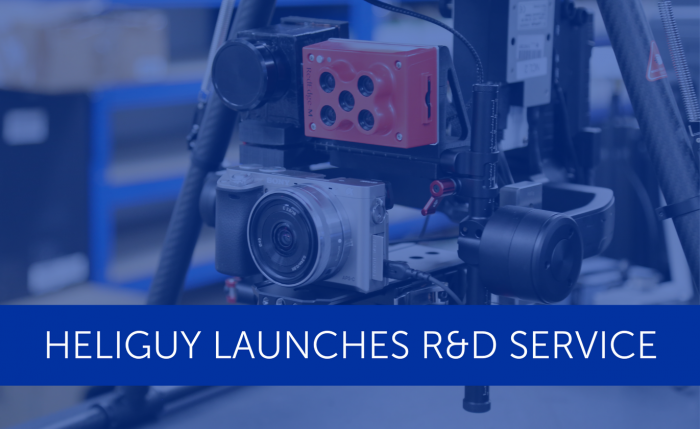
The real-life stories of how UAVs are helping to keep communities safe were told during a recent Emergency Services Roadshow, staged by Heliguy, in conjunction with DJI, at Lincoln’s Waddington Training Site.
The drone was just brilliant. I have absolutely no doubt in my mind that it saved the man’s life.
LINCOLNSHIRE POLICE
The day-long event also doubled up as the UK launch of the DJI Mavic 2 Enterprise and was attended by a range of emergency-service personnel, including representatives from almost half of UK police forces.
Addressing a packed audience, keynote speakers from Lincolnshire, Wiltshire and Devon and Cornwall Police Forces highlighted how drones are a much-valued addition to the police arsenal.
Described as mobile CCTV, UAVs are being utilised for a cross-section of purposes. These include:







In many cases, this technology has turned crews from heroes into superheroes, with numerous examples of how UAVs have been the difference between life and death.
Mark Talliss
REPRESENTING Wiltshire Police
Drones allow us to pre-position each unit before we deploy from the ground and it is also great for capturing evidence. Drones are a massive game-changer. We can see what’s going on and watch the movement of people. Having footage go straight to the control room in real time is so beneficial. You can’t write this stuff.
HOW A DRONE DISCOVERED A MAJOR DRUGS HAUL
Lincolnshire Police has used its drones on more than 300 jobs.

In June, the drone unit landed its first successful prosecution after a man was jailed for three years for producing cannabis.
Following a scouting mission, and as a result of evidence captured by the drone, a cannabis farm was found. It was a significant discovery, with the site described by police as a professional cannabis growing operation which could produce more than £50,000 worth of the Class B drug.
Recalling the night of the operation, a police spokesman said: "We had received information that this man was potentially growing cannabis and we knew that he had done so before.
"Where this man lived was surrounded by trees and bushes, so it was actually like a compound. Our intelligence officers spoke with our drone operators and asked if our drone’s thermal imaging could help – we agreed this could work and started our operation at 2am one morning.
"We turned up and flew the drone 400ft across an open field, before hovering 50m from the property. The heat source was obvious and we scrolled through our different filters to highlight the heat in a number of different spectrums. The filming from the drone took one minute and 20 seconds, and it was only in the air for five minutes from start to finish.
"From here we passed the footage on to the investigating team who used this to get a court warrant for the first time in Lincolnshire.
"It was great to be able to show this evidence in court as it provides a visual that couldn’t really have been done in any other way. Admittedly, the National Police Air Service helicopter could have done this, but this would have been at a cost of about £3,000 per hour, and we did this as part of our routine duties.
All we had to do is charge up the drone. This is an incredibly useful resource available to us and we will continue to use tactics like this to confirm or deny – but only acting on intelligence which has already been collated.
LIVES SAVED WITH DRONES
Drones are also proving to be vital in searching for missing people - and in some cases, they have been the difference between life and death.
The benefits of using UAVs as a search and rescue tool are shown in this excellent video, posted on Twitter by Wiltshire Police. Can you spot missing 11-year-old Fin in this demonstration drone search?
https://twitter.com/wiltshirepolice/status/1031887590541205504
While this video shows demonstration drone-search footage, there are numerous examples of how police have utilised UAVs in real-life scenarios to locate missing and vulnerable people.
Speaking at the Heliguy roadshow, Mark Talliss, representing Wiltshire Police, told an emotive story about how the use of a drone saved the life of a missing 13-year-old girl.
He said: "This girl, who had been bullied at school for months, was dumped by her boyfriend. One morning, she left her home at 5am. 11pm comes round and she hasn’t come home and she has turned her phone off.
"Eventually, she rings her best friend, saying ‘I think I’m dying. I want to say goodbye. I am in a ditch underneath a tree and I am completely numb'.
"Police were told and we had an idea about where she might be, but the officers on the ground couldn’t see her because of where she was and the thick vegetation around her.
But the drone, using a thermal camera, detected her. I believe that if we didn’t have the drone, she would have been found dead in the morning.
From the young to the old, Wiltshire Police also used its drone to find an 83-year-old woman, who was believed to be at a high and potentially immediate risk of harm.
A large on-the-ground team was sent to search a wooded area near to where she was last seen, while the police drone, equipped with a thermal-imaging camera, was dispatched and arrived at the scene around 30 minutes later.
Within an hour, the drone located a heat source on the edge of a wooded area and on closer inspection, the outline of a person laying on the ground could be seen.
The drone hovered over the area directly above to guide officers on the ground in and the patient was located. She had been outside for more than five hours and was suffering with exhaustion and pain as a result of the cold weather.


Meanwhile, Lincolnshire Police used drone technology with a thermal camera to find a crash victim in the winter of 2018.
At 2.20am on February 25, the Force received a report of an overturned car and a man had been seen wandering away from the smoking vehicle. The witness was concerned about his safety in the sub-zero temperatures, so he notified officers.
Initially, a ground search was conducted around a 1.5-mile stretch of the accident location. However, the missing man was nowhere to be found. The challenge was to search a large rural area at night, in the dark, with a small team of officers and only an approximate direction of where the man had headed to. The freezing conditions also posed a serious threat to the missing, injured man. The clock was ticking.
So, Lincolnshire Police turned to another method to conduct the rescue mission. Step forward on-duty drone pilot Special Sergeant Kevin Taylor with the DJI Inspire 1 equipped with a Zenmuse thermal camera to scan the crash site and 500 metres around it. At 3.33am, he was ready for take off and the mission had immediate results.

“Twelve minutes into the flight I detected a heat source, and I directed the officers to check out that heat source.”
S/Sgt Taylor, one of the keynote speakers at the Heliguy roadshow and is pictured (left) at the event.
When the officers arrived, they confirmed that it was a male who was injured, unconscious and hypothermic. He was in a six-foot-deep ditch, which made verifying his identity extremely difficult for the officers who were relying on just the human eye.
With the enhanced perspective of a drone, officers were able to quickly pinpoint his location and direct the medical team to rescue him. Moments later, he was given first aid at the scene, then escorted to the local hospital where he made a full recovery. The video below shows the moment that the man was located.
S/Sgt Taylor said: "In this situation, the drone was just brilliant. I have absolutely no doubt in my mind that it saved this man’s life."
EYES FROM THE SKY HELP TACKLE FIRES
Police are also using drones to help during a fire. This video, posted on Twitter by Lincolnshire Police, shows footage captured from a UAV of a blaze near Gainsborough. By seeing the bigger picture - a view which could not be seen from the ground - commanders were able to make better decisions about how to tackle the blaze and strategically deploy personnel.
https://twitter.com/lincsCOPter/status/1021868216874872832
Wiltshire Police have also used drones to help tackle fires. Mark Talliss said that a drone was used for a fire at a recycling plant. He said: "Using the drone, we were able to see the scale and size of the fire and identify where the hot-spot was, so the fire crews knew which area to target."
KEEPING AN EYE ON THE CROWDS
Police are using drones for crowd control and situational awareness. A very recent example of this was in Lincoln, where police used a drone and thermal camera to monitor the hoards attending the city's popular Christmas Market.
https://twitter.com/lincsCOPter/status/1070747371510919169
OTHER EXAMPLES
There are countless other examples of how drones have helped police carry out their vital work. These include:
The traveller site
Thanks to a drone, Wiltshire Police discovered more than they bargained for when inspecting a traveller site from the sky.
The Force had initially been called to check out reports of human-trafficking victims being housed at the site in ramshack accommodation and being used for cheap labour.
The drone was used to give a bird’s-eye view of the site and to also ensure the safety of officers on the ground.
But the view from the sky helped to uncover an unexpected series of offences.
First, it detected £200,000-worth of stolen electrical cable from the nearby railway. Using a thermal camera, a cannabis factory was identified at the site, while a stash of weapons buried in the ground were also discovered.
Dealing with a firearm incident
Wiltshire Police was called to a house following reports of three men with guns. Mark Talliss said: “Using the drone on scene before we deployed officers allowed us to see the area and spot how to proceed. It was invaluable."
Locating a rape victim
In October, a teenage girl who called 999 to report she was in an unknown location with a man who had just raped her was found by Lincolnshire Police using a drone.
The 16-year-old contacted police in the early hours of the morning to say she was on land in Boston with her attacker.
Police recognised the description given as a levelled factory site and officers used a drone with a thermal imaging camera to track them both down.
RTCs
Police are using drones to help them analyse crash sites. This can be useful during the incident, as well as after for evidence gathering and building information about how the crash happened.
In one example, police used a drone with a thermal camera to search for injured people down an embankment on the side of a motorway.
Training
Footage recorded by drones can be a great asset for training existing officers and trainees/new recruits.
Mark Talliss said: "Drones are so beneficial for training. If we can get a drone to capture some footage, we can then play it back to students.
"It also allows us to look at how we carried out a scenario and review it - what was good, what was bad and how can we improve?"
WHAT NEEDS TO BE CONSIDERED BEFORE USING DRONES?
PC Tom Shainberg, lead drone operator for Devon and Cornwall Police, which works in conjunction with Dorset Police, was the final keynote speaker at the Heliguy roadshow and part of his presentation focused on what officers consider before using drones, especially at a large-scale event.
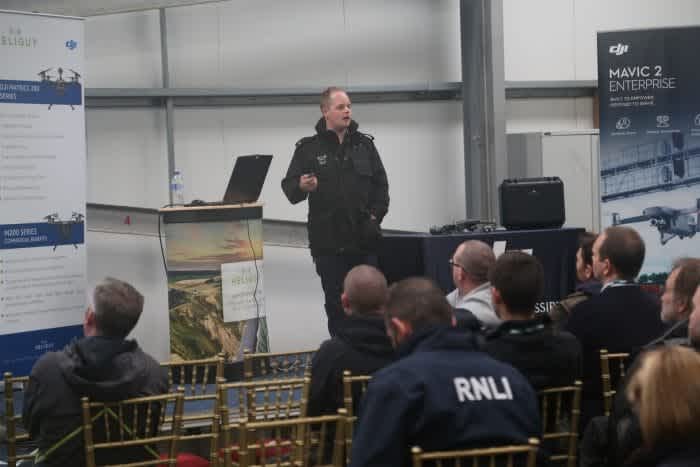
PC Shainberg, pictured above, used the Boardmasters Festival as a case study. The annual four-day gathering, staged in Cornwall during August, attracts approximately 50,000 party-goers, with the majority camping out. The site is large and next to cliffs at Newton Abbot.
PC Shainberg set out how the drone team tackles the operation.
As part of the preparation, the site is scoped out beforehand, including a recce a couple of days ahead of the event (see picture below), scanning the site and obtaining images for pre-event briefing. Other considerations include:

How many drones?
What is the connectivity like on site?
Where will the power source come from?
Welfare of drone staff, including where will the team be located, how many and for how long?
How much data will be gathered?
Is there restricted airspace for the event?
“A lot of planning goes into this,” said PC Shainberg. But he says it is worth every minute and using drones is so beneficial.
He added: “It opens up the event and allows us to cover a large site much easier. It gives as better capability and the zoom camera allows us to pick up faces if needed.”
https://twitter.com/PoliceDronesTom/status/1028842107522494466
Devon and Cornwall Police use Mavic drones and the Force has recently teamed up with DJI to feature in its promotional material for the company’s recently-released Mavic 2 Enterprise, which is available to buy from Heliguy. The Universal Edition costs £2,069.
This new aircraft has been designed with public safety, inspection, search and rescue, fire response and law enforcement in mind and can have spotlight, speaker and beacon accessories fitted to it.

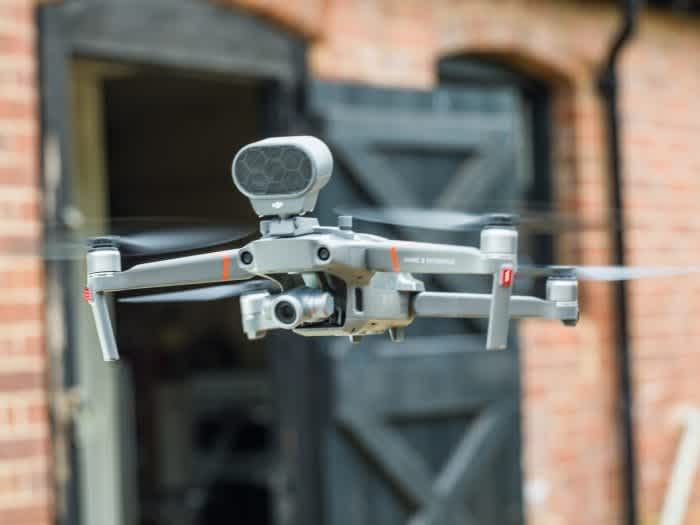
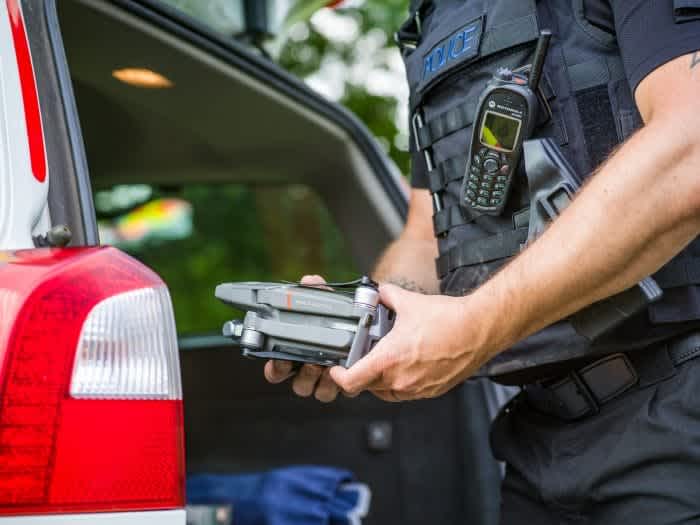

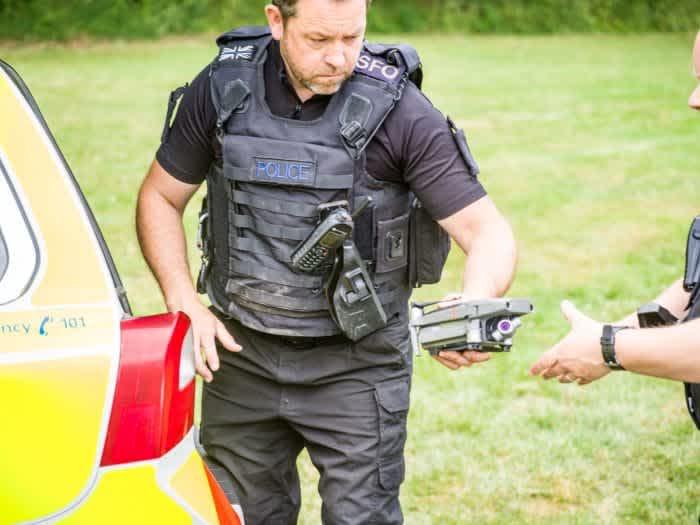

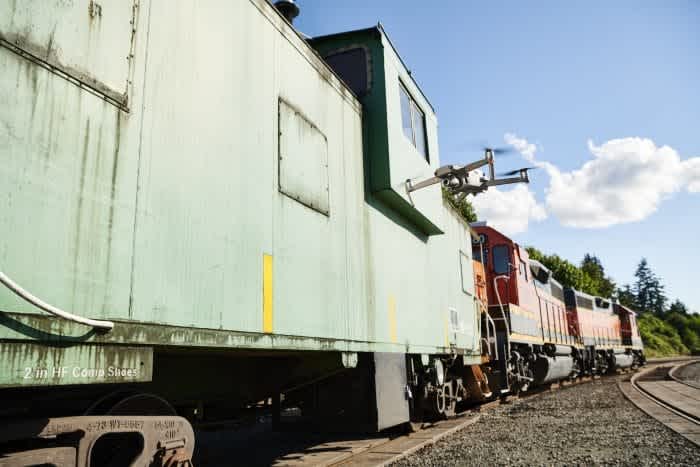



PC Shainberg described the Mavic 2 Enterprise as a massive step forward and praised the spotlight and the speaker accessories in particular. He added: “The password requirement gives a good layer of protection for us, while the battery, which can operate down to -10°C, is another positive.”

Mavic 2 Enterprise Key Features
Compatible with three accessories - loud speaker, dual spotlight and beacon (all pictured, left)
Light, foldable, slim and easy to carry
Self-heating batteries for adverse environments
Long battery life - over 30 minutes of flight time
24GB of internal storage
2x optical, 3x digital zoom camera
Password protection
As part of the advertising material for the Mavic 2 Enterprise, PC Shainberg features in a special promotional video. His comments in the piece perhaps best sum up how the police are utilising drone technology.
He said: “About half of the UK police forces are actively deploying drones. Drone technology has given us much better situational awareness on incidents and it is making things a lot safer for our officers.”
And it seems as though the police's approach to drone technology is being recognised by the public. Earlier this year, Wiltshire Police's Special Constabulary Drone team scooped the prestigious Technical Innovation Award at the Home Office Lord Ferrers Awards.
I am delighted that the Wiltshire Police drone unit has won this national award. It's a real feather in the cap for our Special Constabulary. This 'eye in the sky' technology helps police and other emergency services on the ground to find casualties. As well as safeguarding vulnerable people, our experienced drone pilots can help to track down offenders seeking to evade arrest. I am committed to keeping Wiltshire Police at the forefront of modern technology and leading the way with innovation to maintain Wiltshire as one of the safest places in the country to live.
Police and Crime Commissioner for Wiltshire and Swindon, Angus Macpherson
Lincolnshire, Wiltshire and Devon and Cornwall Police Forces have all purchased equipment from Heliguy.
